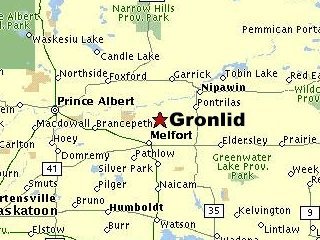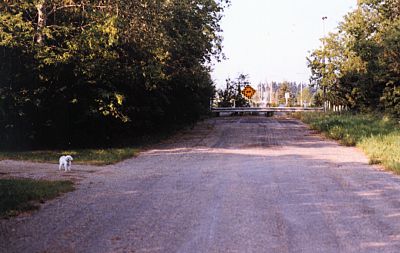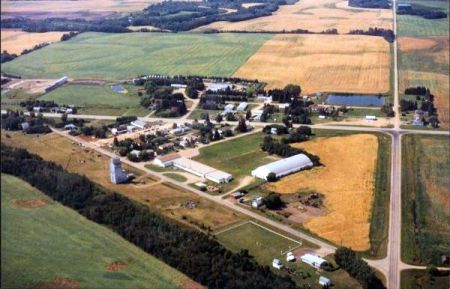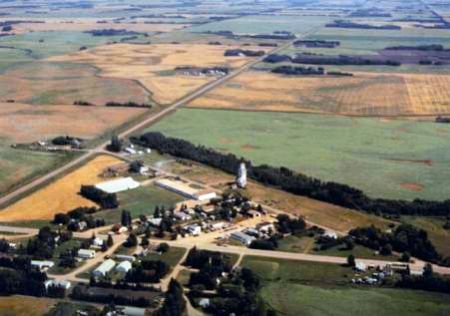Lateral Thinking
or
The Great Gronlid Intersection Debate

|
Gronlid is my home. I was going to say "home town", but it isn't a town. It's not even a village. It's a hamlet. Fewer than 100 people live in Gronlid. It is situated in northeast Saskatchewan on number 6 highway. Number 6 highway forks when it hits Gronlid from the southwest, with one branch curving to head north through the hamlet, continuing as number 6 towards Choiceland. The other branch of the fork becomes highway number 335 and proceeds northeasterly along the edge of the hamlet to its northeast corner, where it bends 45 degrees and heads east towards Armley (figure 1). 
figure 1 At least, that's the way it was prior to The Debate. About 10 years ago, Saskatchewan Highways rebuilt number 335. Damn good thing, too. Local residents opined that the road was named 335 because that's how many potholes there were to the mile. Prior to completing the reconstruction, Sask Highways approached the R.M. of Willow Creek to seek guidance. "Would you like us to rebuild the road along its present route along the eastern edge of Gronlid, or would you prefer that we push it straight across the north edge of Mikulsky's slough to join onto number 6?" "The latter, please," replied the R.M. (figure 2).  figure2 And so it was done. And so it might have ended, but shortly after the road was completed came the proposal that led to The Great Gronlid Intersection Debate. The proposal originated with a couple of Gronlid's "movers and shakers" - specifically, the principal and the janitor of the school who, between them, comprised two-thirds of the Hamlet Board. "Now that number 335 joins number 6 on the north end of Gronlid," they thought, "why don't we get the R.M. to block off the road running along the east edge of town at its north end by Frank Panchyshyn's place?" (figure 3) This modification, they reasoned, would drastically reduce the numbers and the velocity of vehicles, which heretofore had been speeding - truly! - down the road past the school.  figure 3 Referring back to figure 1 you can see the problem that gave rise to the proposal. A vehicle approaching from the south needed only decelerate slightly (if at all) to navigate the slight jog in the road at the southern boundary before regaining highway speeds past the school, slowing again before rounding the curve and heading full throttle for Armley. No kids had yet been hit, but the operative word was "yet".  Junction of Main Street and Highway 335 So a meeting was held in the Gronlid Hall to attain consensus. (Why there was no meeting held to discuss the rebuilding itself of 335 across the north edge of town, I don't know. But there would be a meeting to discuss the roadblock). Now, attendance for hamlet meetings usually runs at about seven people, so it surprised me when I entered the hall that night to find forty or fifty people, including the Reeve and the R.M. Secretary. A good many of those assembled came not from Gronlid proper, but from its environs, the farms surrounding Gronlid - most particularly those to the north and east of Gronlid. I entered the hall with the dimly formed thought that as usual, there would be little discussion and that the proposal would be quickly approved, Gronlidians being on the whole a pretty amiable bunch. It soon became obvious that this was not to be the case. Opinions, I found, were sharply divided. And hotly debated. Rural folks, though generally amiable, tend to be forthcoming about their views on any subject. Dissenting arguments included the following:
 figure 4 It was at this point that I felt compelled to toss in my two cents as the self-appointed expert on intersection accidents, by virtue of the fact that I had once been the in-class instructor of Driver Ed at the high school, and because, when I was sixteen years old, I had one. (At about noon on a fine spring day in 1961, old Sammy Williamson T-boned me on the main street of Indian Head, Saskatchewan . . . but that is another story). In case you have not already guessed, I should tell you that I was siding with the principal and the janitor. I wanted the road blocked off. I must confess that my motives were not entirely altruistic, since my driveway emptied onto the road in question. Not only was I concerned about my family and my pets, I was concerned about myself backing out of the driveway and into traffic that resembled the clubhouse turn at Daytona. Nonetheless, I felt I was being quite objective and was under the impression that my arguments in favour of closure were both cogent and compelling. Apparently, the high opinion I held of my powers of persuasion was not universally shared. In the midst of my brilliant dissertation, Mary Skolosky interrupted me. "How would you like it if we closed off the road at YOUR end?" she fired. After the initial shock of having my expertise thus challenged, it dawned on me. "You mean, the OTHER end, Mary? The SOUTH intersection? I think that is a GREAT idea! I would like to make a motion to that effect."  figure 5 You see, not only would Mary's proposal (or, as she perceived it, threat) slow the traffic past the school, it would completely eliminate the traffic past my driveway. The people most directly affected by the proposed southern closure would be me and Marty, my neighbour across the road. And since Marty was not present at the meeting, I felt free to speak for him. More discussion followed. It was true, there had been accidents at that southern intersection. It was a bad corner. Let's vote. All in favour? All opposed? Carried. Unanimous! It would not surprise me to learn that this was the only unanimous vote in the history of Gronlid, where family feuds carry on for generations. (If he's for it, I'm against it. I got no use for any of them. His grandfather drained water onto my grandfather's land . . . ) I also suspect that there may be some at the meeting who considered my motion to be a selfless one. I think I was seen by some as disaccommodating myself - in effect, "taking one" for the community. I did nothing to dispel the illusion. After the meeting adjourned, I made my way over to Mary. "THANK you, Mary! That was a wonderful suggestion! Great idea!" Mary looked a little flustered, torn between being flattered and being peeved. She had not, after all, meant it to be helpful. I meant what I said, though. She was the only one in the meeting who demonstrated anything that approached lateral thinking. The rest of us were completely focussed on the north intersection and had assumed entrenched positions pro and con, never stopping to think that there might be other options which would meet everybody's interests. Two weeks later, Saskatchewan Highways blocked the south intersection by sinking a series of posts into the pavement. 
So now I live in a cul-de-sac, and if you want to come from Melfort to visit me, you will have to go down to main street, turn right past the Bear's Den, and turn right again back to the south. Mine is the driveway on the left. 
But the story does not end there. Epilogue Even after the posts had been set, it took a while for the change to set in completely. In the years that followed, some individuals would drive up, ease the bumper of their vehicle against a post, snap it off, and continue on their way. And each time Sask Highways repaired the roadblock, they beefed it up, first by adding additional posts, then cement curbing, and finally a metal barrier. Eventually the renegades gave up and all through traffic ceased. Among other things, I think it speaks to the ability of some folks to accept change. |



